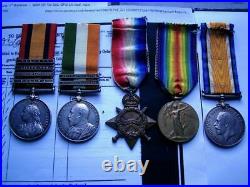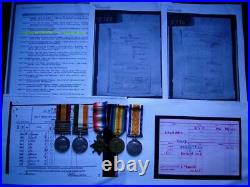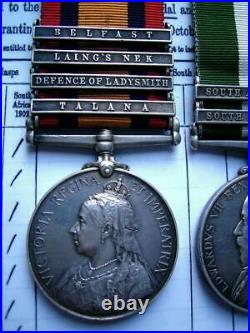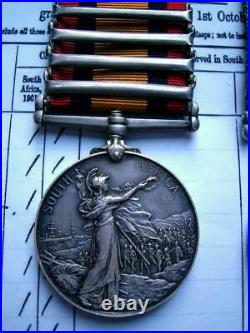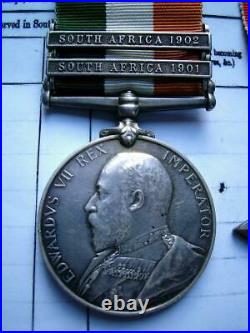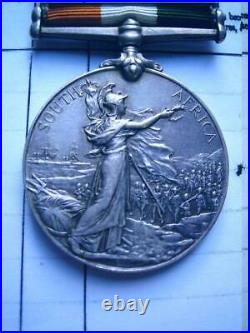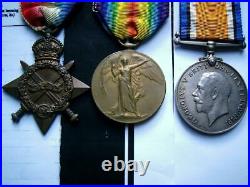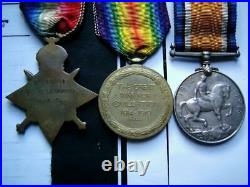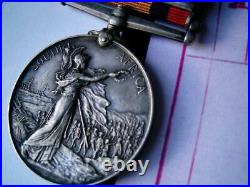Henry Leonard was born at Findern, Northamptonshire in 1875 the son of Thomas and Sarah Leonard. Enlisting on 13 October 1893 with the 2nd Battalion, Leicester Regiment he transferred to the 1st Battalion on 2 January 1896. Posted to South Africa with this unit on 8 January 1896 Leonard served through the Battle of Talana and the Defence of Ladysmith. The Battalion was present for the Battle of Belfast and served throughout the Guerrilla phase of the war. Leonard was transferred to the Depot on 18 August 1902 and posted back to Britain later that year on 13 September. Discharged to the Reserve he served with D Section of the Reserve Battalion from 9 October 1905-9 October 1909 when his period of engagement ended. Having found work as a Labourer he re-attested for the Army Veterinary Corps on 21 July 1915. Leaving Britain for France again on 20 March 1916 he remained there for the duration of the war being placed on furlough between 18 August-1 September 1918. Leonard was discharged on 13 May 1919. Victorian Boer War QSA KSA WW1 medal TALANA DOL LN BELFAST clasp Leicester Regt. Scarce QSA KSA BOER WAR & WW1 medal group with Talana battle clasp. Leonard, I:Leic:Regt”; King’s South Africa 1901-02, 2 clasps, South Africa 1901, South Africa 1902 “3894 Pte H. Leicester: Regt”; 1914-15 Star “Se. “; British War and Victory Medals “Se-10921 Pte. “, all officially named, early version of medal with faint “Ghost dates, IMO Good very fine condition, see pictures for condition, supplied with some service history and medal roll copies. Start of the 2ND Boer war “TALANA HILL” October 1899. The 1st Battalion Leicester Regiment was stationed at Glencoe, in the north of Natal, when the war broke out. It thus formed part of the brigade of General Penn Symons, the other battalions being the 1st King’s Royal Rifles, 1st Royal Irish Fusiliers, and 2nd Dublin Fusiliers. There were also at Glencoe the 18th Hussars and the 13th, 67th, and 69th Batteries RFA. The troops were soon set in motion. To the Leicesters and 67th Battery was assigned the duty of guarding the camp with its great quantities of stores. The general decided to attack with his other infantry and artillery. These moved away and were soon in extended order advancing to a wood, which the commander had decided to use as a breathing place. About 8.50 the infantry again advanced, and as they left the wood had to face a terrible rifle-fire both from their front and flank. Sir W Penn-Symons, who had been exposing himself with rash bravery, fell mortally wounded about 9.30; Brigadier General Yule, now in command, directed the infantry to move to a wall stretching some distance along the hillside, from which wall a very heavy fire was being kept up by the Boers. The two batteries redoubled their efforts. The 1st King’s Royal Rifles on the right first reached the wall, followed by some companies of the Irish Fusiliers; the Dublin Fusiliers also made their way up a little later. After another breathing space under cover of the wall the troops jumped the wall and scrambled up the steep face. Then followed the first blackguardly use of the white flag. Within easy range of our artillery were to be seen clumps of 50 and 100 men on which guns could have inflicted great loss. The enemy, however, displayed a white flag, although they do not appear to have had any intention of surrendering, and in consequence the officer commanding Royal Artillery refrained from firing. One can scarcely acquit this officer from being very easily taken in, as the enemy’s continued movement contradicted any idea of surrender. The infantry had done magnificently; the same cannot be said of the Hussars, or at least those under Colonel Moller, who managed to get lost among the enemy, and was taken prisoner with 200 men. The artillery did well, but it seems beyond doubt that they fired at the hill-top after it was occupied by our people, causing some loss, particularly to the King’s Royal Rifles. The range was short, and artillery officers with proper glasses should have seen when the British troops were up. The Leicesters lost 1 officer killed, 1 wounded, and 1 man wounded. Leicester regiment mounted infantry. On the 21st General Yule moved his camp to a better position. On the 22nd he resolved to retreat on Ladysmith. At nine at night in silence, without bands or pipers, the force set out by the east or Helpmakaar road, the dying general, the other wounded, and the doctors being left. A great mass of stores had also to be left to the enemy, as its destruction would have made him suspect the intended retreat; while, on the other hand, a twelve hours’ start was absolutely necessary. To have fought their way to Ladysmith would have been an impossible task for Yule’s column in that hilly country. As it was, the Boers showed that inexplicable want of energy which seemed at times in the campaign to paralyse them. Probably the good things left in Dundee had something to do with the lack of activity. Fortunate it was that General Yule was not interfered with by the enemy, but the elements were not favourable. The rain at times fell in torrents; roads knee-deep in mud and swollen spruits made marching very heavy work, while but little sleep was obtainable between the 21st and 26th. On the 30th, in the battle of Ladysmith (Defence and later relief), the Leicesters were with Colonel Grimwood on the right and had a very trying day. They had about 24 casualties. After the siege began the Leicesters occupied posts on the north side, and they were not much pressed in the great attack on 6th January 1900. For their work during the siege 2 officers and 3 men were mentioned in Sir George White’s despatch of 23rd March 1900. When the Boers retreated Spring 1900 from natal, every bridge, culvert, reservoir and railway was a target to be destroyed including Lang’s Nek tunnel. The rapid British advance of Spring 1900 prevented the Boers from damaging the tunnel to the extent they wished. They hurriedly dynamited the two entrances to the tunnel before Lord Dundonald and his troops occupied the position May 1900. British discovered the tunnel was not badly damaged and quickly cleared the rubble from the line. This allowed the trains to supply the British advance into the Orange Free State and Transvaal. Lang’s Nek tunnel blocked by explosion made by the Boers may 1900. When, Ladysmith having been relieved and its garrison recuperated, Sir Redvers Buller moved north, the Leicesters were brigaded with the 1st Liverpool, 1st Royal Inniskilling Fusiliers, and 1st King’s Royal Rifles. They were present at Bergendal (Battle of Belfast) and many other actions, but had a remarkable immunity from mishaps and heavy casualty lists. In his despatch of 10th October 1900 Lord Roberts mentions that in the operations about Badfontein on the way to Lydenburg the Leicesters and 1st King’s Royal Rifles pulled a field battery up a steep hill, which did much to assist in compelling the enemy to bolt. Seven officers and 9 non-commissioned officers and men of the battalion were mentioned in General Buller’s despatch of 9th November 1900, and 11 officers and 12 non-commissioned officers and men were mentioned by Lord Roberts in his final despatch. After marching to Lydenburg with General Buller, and taking part in his other operations north of the Delagoa line, the Leicesters remained in the Eastern Transvaal, sometimes trekking, as in General French’s operations, sometimes doing garrison duty. That their work was consistently good is proved by the fact that they got rather more than an average number of mentions in Lord Kitchener’s despatches during the war. For a long time prior to the close of the war they occupied blockhouses on the Standerton-Ermelo road. In the final despatch 4 officers and 6 non-commissioned officers were mentioned. RVC working on an injured horse WW1. During the First World War almost half the veterinary surgeons in Britain served as officers in the AVC, and the number of other ranks in the Corps grew from 934 to 41,755. Innovations included provision of Mobile Veterinary Sections, to transfer sick and wounded horses to veterinary hospitals, and camel specialists, who staffed hospital facilities in Egypt. As well as serving on the Western Front, the AVC was deployed with animals to such contrasting theatres of war as Gallipoli, Salonika, Mesopotamia and Palestine. In 1918 the Corps was given its Royal prefix in recognition of its service through the First World War. At the time the Quartermaster-General wrote. The Corps by its initiative and scientific methods has placed military veterinary organisation on a higher plane. The high standard which it has maintained at home and throughout all theatres has resulted in a reduction of animal wastage, an increased mobility of mounted units and a mitigation of animal suffering un-approached in any previous military operation. Hundreds of thousands of horses died during WW1, due to disease, injury, starvation and shelling, they became in very short supply by 1917, considered more valuable than a soldier as they were essential for logistical work, pulling large loads through difficult terrain, mud and shell holes made it almost impossible to use mechanised vehicles. Demobilisation in 1919 after the war was followed by mechanisation, and consequentially the RAVC was greatly reduced in size. Auctiva gets you noticed! Track Page Views With. Auctiva’s FREE Counter. The item “Victorian Boer War QSA KSA WW1 medal TALANA DOL LN BELFAST clasp Leicester Regt” is in sale since Saturday, December 4, 2021. This item is in the category “Collectables\Militaria\Boer War (1899-1902)”. The seller is “theonlineauctionsale” and is located in Offchurch. This item can be shipped worldwide.
- Country/Region of Manufacture: United Kingdom
- Country/ Organization: United Kingdom
- Issued/ Not-Issued: Issued
- Theme: Militaria
- Type: Medals & Ribbons
- Conflict: Boer War (1899-1902)
- Service: Army
- Era: 1816-1913
